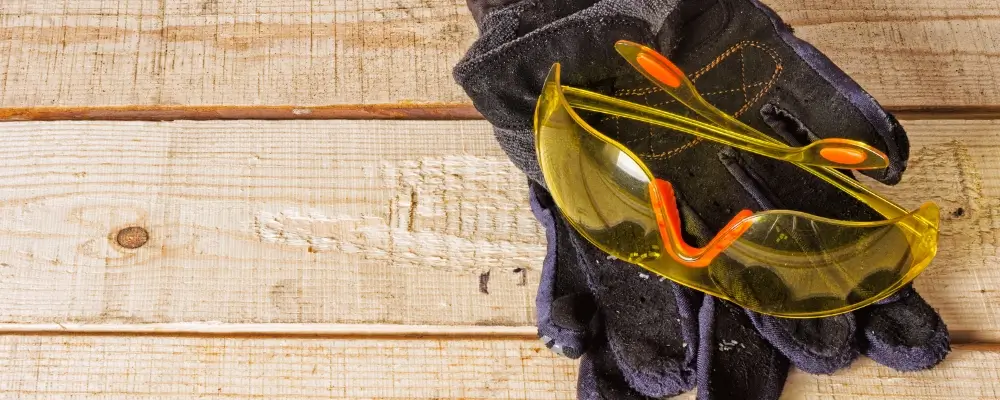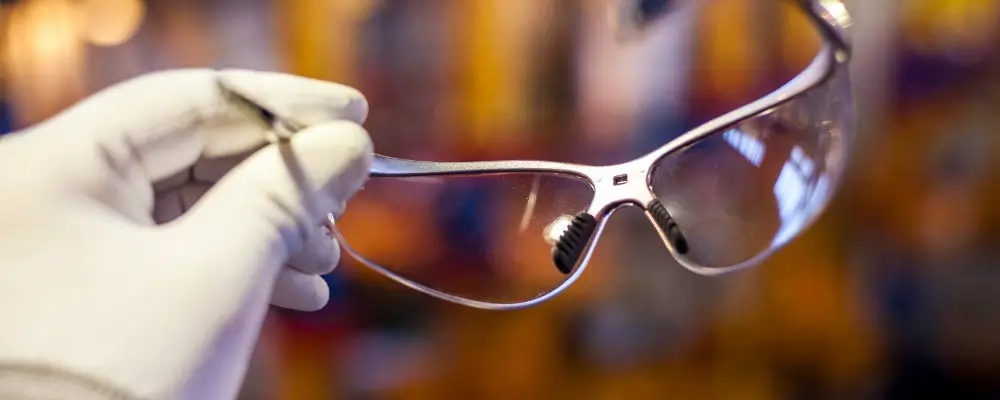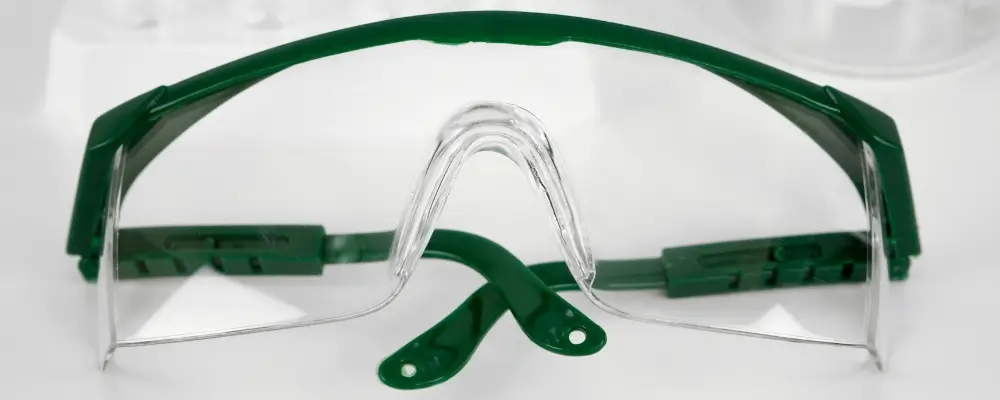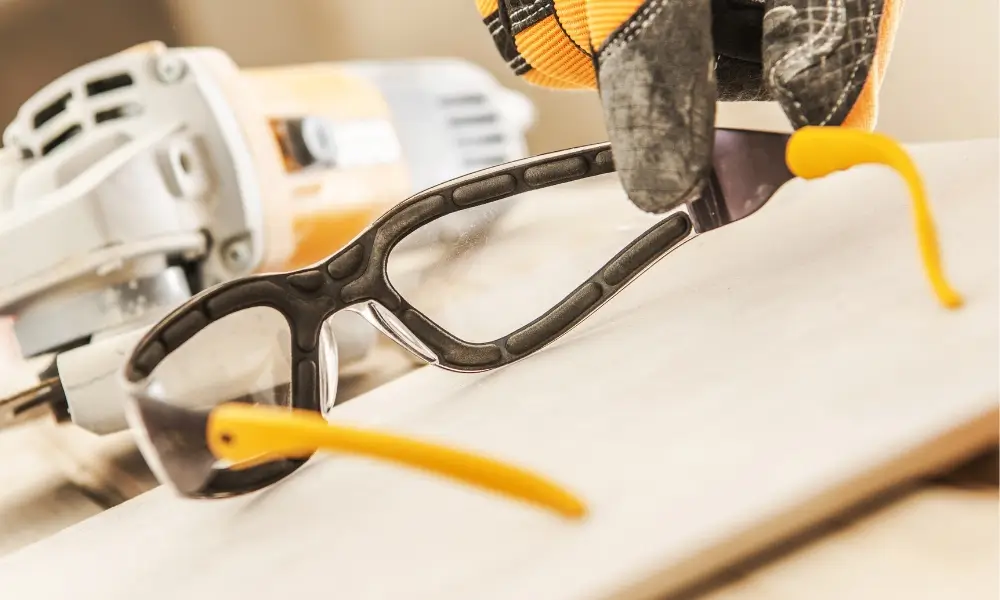Our eyes are invaluable tools, and they face various potential dangers in the workplace. From flying objects to chemical splashes, workplace accidents can lead to serious eye injuries or even permanent vision loss. This is where the ANSI Z87.1 standard comes into play. Developed by the American National Standards Institute, this eye and face protection benchmark ensures that the safety glasses you wear are rigorously tested and designed to protect you in the event of an incident.
Understanding this standard is crucial for anyone involved in manufacturing, choosing protective equipment, or working in an environment with eye hazards. Let’s delve into the details of ANSI Z87.1 and discover how it ensures workplace safety.
The American National Standards Institute (ANSI) is a private non-profit organization that oversees the development of consensus standards for products, services, processes, and systems within the United States. Their ANSI Z87.1 standard has become the occupational eye and face protection device benchmark. By choosing safety glasses that comply with ANSI Z87.1, you can be confident that they offer the necessary level of protection for your workplace environment.

Understanding the ANSI Z87.1 Standard
The American National Standards Institute (ANSI) Z87.1 standard is a critical benchmark in personal protective equipment, specifically focusing on eye and face protection. It sets forth criteria for the design, performance, testing, and certification of safety glasses, goggles, face shields, and other forms of protective eyewear. Understanding this standard is essential for manufacturers, employers, and workers alike to ensure the highest level of safety in environments where eye hazards exist.
History and Evolution of the ANSI Z87.1 Standard
The ANSI Z87.1 standard has a rich history that reflects the evolving understanding of workplace safety and technological advancements in protective eyewear. Initially established in the 1960s, the standard has undergone several revisions to address the changing needs of the workforce and incorporate new materials and technologies. Each revision aims to improve clarity, enhance protective features, and ensure the standard keeps pace with current safety research and eyewear manufacturing innovations.
Significant updates have been made, with revisions in 1989, 2003, 2010, and more recently. These updates have introduced concepts such as increased emphasis on impact protection, classifying lenses into basic and high-impact levels, and specific requirements for various hazards, including optical radiation, liquid splash, dust, and fine particles.
The Scope of the ANSI Z87.1 Standard
The scope of the ANSI Z87.1 standard is comprehensive, covering all products designed to protect the eyes and face from injuries due to impact, radiation, chemical exposure, and other specific hazards encountered in workplaces and certain sports activities. It specifies performance requirements for protective devices, including criteria for impact resistance, optical quality, durability, and coverage.
The standard applies to manufacturers and suppliers of eye and face protection equipment, ensuring that products meet stringent safety criteria before reaching the market. It also guides employers and safety professionals in selecting appropriate protective eyewear for their specific needs, promoting a safer working environment.

Key Definitions and Terms Used in the Standard
Understanding the key definitions and terms used in the ANSI Z87.1 standard is crucial for interpreting its requirements accurately. Some of the essential terms include:
- Impact Resistance: The ability of a lens or face shield to withstand the impact of a projectile without cracking, detaching, or creating fragments that could injure the eye.
- Optical Clarity: A measure of the clearness and sharpness of vision provided by the protective eyewear, ensuring the wearer can see accurately without distortion.
- High Impact: Classification of protective eyewear that can withstand high-velocity impacts provides more excellent protection than essential impact eyewear.
- Side Protection: Requirements for protective eyewear to shield the area around the eyes, preventing injury from side impacts or splashes.
- Markings: Specific symbols and letters used on eyewear to indicate the manufacturer, the standard it meets (Z87.1), and the level of protection it provides (e.g., “Z87+” for high-impact protection).
These terms, among others defined in the standard, form the foundation for understanding the requirements and ensuring compliance. By adhering to the ANSI Z87.1 standard, manufacturers and employers can significantly reduce the risk of eye and face injuries, promoting a culture of safety and prevention in the workplace.

Key Requirements of ANSI Z87.1
The ANSI Z87.1 standard establishes a comprehensive set of requirements to ensure the highest safety and protection for individuals wearing eye and face protective equipment. These requirements are meticulously outlined to cover various aspects of safety eyewear, including design, construction, testing, and performance criteria. Here’s an overview of the key requirements set forth by the ANSI Z87.1 standard:
Impact Resistance
One of the ANSI Z87.1 standard’s core components is the impact resistance specification. This ensures that lenses and face shields can withstand impacts from projectiles and other objects without breaking, cracking, or dislodging. The standard differentiates between basic impact and high impact levels:
- Basic Impact: Eyewear must pass a test involving a 1-inch diameter steel ball dropped from a height of 50 inches.
- High Impact: Eyewear must withstand the impact of a quarter-inch steel ball traveling at a speed of 150 feet per second. High-impact protective devices are marked with a “+” symbol next to the Z87 marking.
Optical Clarity
The standard sets forth criteria for optical clarity to ensure that protective eyewear does not distort or impair vision, which could potentially lead to accidents. It includes specifications for refractive power, astigmatism, prismatic power, and haze, ensuring that wearers have a clear and accurate vision while using protective eyewear.
Durability and Testing Methods
Durability is another critical aspect covered by the ANSI Z87.1 standard. It includes requirements for the resistance of lenses and frames to corrosion, heat, impact, and other environmental factors that could compromise the safety and effectiveness of the eyewear. The standard outlines specific testing methods to assess the durability and performance of protective eyewear under various conditions.
Coverage and Side Protection
To provide adequate protection against hazards coming from different directions, the ANSI Z87.1 standard requires that safety eyewear offer sufficient coverage around the eyes. This includes side protection against impacts and splashes, ensuring the area around the eyes is shielded from potential hazards. To meet this need, the standard specifies the design and construction requirements for side shields and other protective features.
Lens Types and Use Markings
The standard also categorizes lenses based on their intended use and the level of protection they offer against specific hazards, such as ultraviolet (UV) light, infrared (IR) radiation, laser beams, and chemical splashes. Each category has a marking system that indicates the lens type and its suitability for different environments or activities. These markings help users select the appropriate eyewear for their specific needs.
Manufacturer’s Markings
Every piece of protective eyewear that meets the ANSI Z87.1 standard must bear the manufacturer’s mark and the specific standard (Z87) it complies with. If the eyewear provides high-impact protection, it includes the “+” symbol. As mentioned above, additional markings may indicate suitability for specific hazards or conditions.
By adhering to these requirements, the ANSI Z87.1 standard ensures that individuals are protected against various hazards in various environments. Compliance with the standard is crucial for manufacturers, employers, and safety professionals to safeguard the well-being of individuals exposed to potential eye and face injuries in their work or activities.

Additional ANSI Z87.1 Protections
ANSI Z87.1 goes beyond impact protection to cover other potential workplace eye hazards. Here’s a look at some key additional protections:
Non-ionizing Radiation
- Welding (W): Welding shades have numbered markings (e.g., W3, W5) indicating the darkness level needed for different welding processes. These lenses protect against harmful infrared and intense visible light.
- Ultraviolet Radiation (U): Lenses with a ‘U’ rating have UV-filtering properties. The numbered scale (e.g., U2, U6) denotes the level of UV protection provided.
Dust, Droplets, and Splashes
- Dust (D3): These glasses offer protection against fine dust particles.
- Droplets (D4): Safety glasses designed to protect against splashes or droplets of liquids.
- Splashes (D5): This indicates protection from significant splashing liquid.
Important Note: Even with these ratings, ANSI Z87.1 safety glasses often don’t offer sufficient protection against chemical hazards that call for the full sealing coverage of goggles.
Choosing the right protection:
It’s crucial to understand that ANSI Z87.1 offers additional codes on its compliant eyewear that signify these specific protections. When making a purchase, pay careful attention to any markings that go beyond the basic ‘Z87’ or ‘Z87+’ designations. These additional codes will ensure the safety glasses you choose are suitable for the full range of hazards present in your workplace.
Let me know if you’d like to explore how to choose the right ANSI-compliant safety glasses or discuss any other sections of the standard!

Choosing the Right ANSI Z87.1 Safety Glasses
Equipping yourself with ANSI Z87.1-compliant safety glasses is a crucial step towards eye protection, but with various options available, selecting the right pair requires careful consideration. Here’s a guide to navigating this process:
Hazard Assessment:
- The first and most important step is to identify the specific hazards present in your workplace. Common hazards include flying debris, dust, chemical splashes, radiation, or a combination.
- By understanding the potential threats, you can choose glasses with the appropriate ANSI Z87.1 markings (e.g., Z87+ for high-impact, D4 for liquid splashes).
Fit and Comfort:
- Safety glasses that don’t fit properly won’t offer optimal protection and might not be worn consistently.
- Look for glasses that sit comfortably on your face without slipping or causing pressure points. Adjustable temples and bridge pads can help achieve a secure and comfortable fit.
Style:
- While safety is paramount, a comfortable and stylish pair of glasses is more likely to be worn consistently.
- Manufacturers offer a variety of styles and lens colors to suit different preferences, ensuring safety doesn’t have to compromise on looks.
Special Considerations:
- Do you wear prescription glasses? Consider safety glasses with over-the-glasses (OTG) designs that fit over your existing prescription eyewear.
- Working in environments with fog or moisture? Anti-fog coatings on the lenses can be a valuable addition.
Here are some additional tips for choosing ANSI Z87.1 safety glasses:
- Consult your employer’s safety guidelines for specific recommendations.
- Look for reputable safety equipment suppliers who can guide you in selecting the right glasses for your needs.
- Don’t hesitate to try on different pairs to find the best fit and style for you.
By following these steps and prioritizing safety and comfort, you can choose ANSI Z87.1-compliant safety glasses that protect your eyes and ensure a worry-free work environment.
Next, we can explore the proper care and maintenance of your safety glasses to ensure they remain effective for a long time.

Compliance and Enforcement
Compliance with the ANSI Z87.1 standard involves several key components:
- Manufacturers: They must design, test, and certify their protective eyewear products by the ANSI Z87.1 requirements. This includes ensuring eyewear can withstand impacts, provide adequate protection from specific hazards, and meet the standard’s optical clarity and durability criteria. Products that meet these requirements are marked with the ANSI Z87.1 designation and additional markings that indicate the level of protection offered.
- Employers: Organizations that operate in environments where eye and face hazards are present are responsible for providing their employees with ANSI Z87.1-compliant protective eyewear. This involves assessing the risks in their workplace, selecting appropriate safety eyewear that offers the necessary level of protection, and ensuring that employees use the protective equipment as required.
- Employees: Workers must use the provided protective eyewear by training and instructions. This includes appropriately wearing the eyewear in all situations where eye and face hazards are present and reporting any damage or issues with the protective equipment to their employer.
Enforcement
Enforcement of the ANSI Z87.1 standard is primarily the responsibility of regulatory bodies, with the Occupational Safety and Health Administration (OSHA) playing a key role in the United States:
- OSHA: As part of the U.S. Department of Labor, OSHA enforces workplace safety and health regulations, including the use of ANSI Z87.1-compliant protective eyewear in environments where eye and face hazards exist. OSHA’s regulations require employers to provide appropriate personal protective equipment (PPE) to their employees and ensure its proper use. Non-compliance with these regulations can result in citations, fines, and other penalties.
- Workplace Safety Inspections: Regular safety inspections and audits, either conducted internally by the organization or externally by OSHA or other regulatory bodies, help ensure ongoing compliance with the ANSI Z87.1 standard and other safety requirements. These inspections assess the adequacy of the protective eyewear provided, its condition, and whether employees are using the equipment as required.
- Training and Education: Part of enforcing compliance involves educating employees about the importance of using protective eyewear, how to select the correct type for specific hazards, and the proper use and maintenance of the equipment. Training programs and safety orientations are essential components of a comprehensive workplace safety strategy.
Compliance with the ANSI Z87.1 standard and its enforcement through regulatory measures and workplace policies are fundamental to protecting workers from eye and face injuries. By adhering to these guidelines, organizations can create safer work environments, reduce the incidence of injuries, and promote a culture of safety and health.
Advances and Future Trends
The field of protective eyewear, particularly in compliance with the ANSI Z87.1 standard, is continuously evolving, driven by technological advancements, changing workplace needs, and a deeper understanding of occupational hazards. These developments are shaping the future of safety glasses and face protection, making them more effective, comfortable, and adaptable to various work environments. Here are some of the key advances and future trends in this area:
Technological Innovations
- Augmented Reality (AR) and Virtual Reality (VR): The integration of AR and VR technologies into safety eyewear is a significant trend. These technologies can provide real-time information, enhance training, improve navigation, and increase situational awareness, all while offering the necessary protection against physical hazards.
- Anti-Fog and Scratch-Resistant Coatings: Advances in lens coatings significantly improve visibility and durability. Anti-fog technologies are becoming more effective in preventing lens fogging in extreme temperature changes, while scratch-resistant coatings extend the life of safety eyewear.
- Improved Impact Resistance: Materials science advancements are leading to the development of lenses and frames that offer superior impact resistance without compromising on weight or comfort. This includes new polymers and composite materials that absorb impact energy more efficiently.
Enhanced Comfort and Wearability
- Customization and Fit: Future trends point towards more customizable safety eyewear options, allowing for adjustments in size, shape, and strap configurations to accommodate different face shapes and sizes. This customization enhances comfort, encourages consistent wear, and improves protection.
- Lightweight Materials: The use of lightweight materials not only improves comfort for wearers over long periods but also enhances the overall wearability of safety glasses and goggles. This is crucial for ensuring that protective eyewear is used consistently and correctly.
Environmental and Health Considerations
- Sustainable Materials: There is a growing trend towards using eco-friendly materials in the production of safety eyewear. Manufacturers are exploring biodegradable, recycled, and sustainable materials to reduce environmental impact.
- Protection Against Emerging Hazards: As new occupational hazards emerge, including those related to blue light exposure from digital screens and potential risks from new manufacturing technologies, safety eyewear is adapting to offer protection against a broader range of risks.
Regulatory and Standards Evolution
- Global Harmonization: Efforts are underway to harmonize safety standards across different countries and regions, making it easier for multinational companies to comply with protective eyewear requirements and ensuring a high level of protection for workers worldwide.
- Dynamic Standards: The ANSI Z87.1 standard and similar regulations are expected to evolve more dynamically to keep pace with technological advancements and emerging workplace hazards. This includes faster updates to standards and more agile testing and certification processes.
Predictive Analytics and Wearable Technology
- Smart Safety Eyewear: The integration of sensors and wearable technology into safety glasses and goggles enables the monitoring of environmental conditions, wearer’s health indicators, and exposure to hazardous elements. This data can be used for predictive analytics, offering insights into potential risks and preventing accidents before they occur.
These advances and trends highlight the ongoing commitment to improving workplace safety through innovation in protective eyewear. As technology continues to evolve, the future of safety glasses and face protection looks promising, with enhanced protection, comfort, and functionality that meet the changing needs of modern workplaces.

Maintenance and Care of Safety Glasses
Maintaining and caring for safety glasses are crucial to ensuring they continue to provide the necessary level of protection and remain in good condition over time. Proper maintenance involves correct cleaning and storage practices, regular inspections, and knowing when to replace eyewear. Here’s a guide on how to properly maintain and care for your safety glasses:
Cleaning and Storage
Correct Cleaning Methods:
- Rinse with Water: Begin by rinsing your safety glasses under lukewarm water to remove any dust or particles that could scratch the lenses during cleaning.
- Use Mild Soap: Apply a small amount of mild, non-abrasive soap to gently clean the lenses and frame. Avoid using solvents or harsh chemicals that could damage the lens coatings or frame material.
- Soft Cloth: Use a soft, lint-free cloth or a microfiber cleaning cloth to gently wipe the lenses and frame. Avoid using paper towels, tissues, or rough fabrics that can scratch the lenses.
- Air Dry or Gentle Wipe: Allow the glasses to air dry or gently wipe them with a clean, soft cloth. Do not use excessive force that could bend the frame or damage the lenses.
Storage to Prevent Scratches:
- Protective Case: Always store your safety glasses in a protective case when not in use. This prevents them from getting scratched by other objects and protects them from potential impacts.
- Avoid Extreme Conditions: Store your safety glasses in a cool, dry place away from direct sunlight and extreme temperatures, which can warp the frame and degrade lens coatings.
Inspection and Replacement
How to Spot Damage:
- Inspect Lenses: Look for scratches, cracks, or chips in the lenses that can impair vision or compromise protection. Even small scratches can significantly reduce visibility, especially in bright light or at night.
- Check the Frame: Examine the frame for signs of wear, cracks, or deformities. Ensure that the frame fits properly and does not press uncomfortably against the face or slide off, as this can affect the level of protection.
- Assess Fit and Comfort: Regularly check that the safety glasses fit well and remain comfortable to wear. Over time, the fit can change due to wear and tear on the frame or adjustments in the user’s facial structure.
When to Replace Eyewear:
- Lens Damage: Replace safety glasses immediately if the lenses are scratched, cracked, or chipped, as this can compromise protection and visibility.
- Frame Damage: If the frame is damaged, bent, or no longer holds the lenses securely, it’s time to replace the glasses to ensure they provide adequate protection.
- After Significant Impact: Safety glasses that have sustained a significant impact should be replaced, even if no damage is visible. Impacts can weaken the structure and reduce the level of protection.
- Degradation of Materials: Replace safety glasses if there are signs of material degradation, such as discoloration, brittleness, or if the lenses or frame warp.
By adhering to these maintenance and care guidelines, you can extend the life of your safety glasses and ensure they continue to provide the highest level of protection against workplace hazards. Regular cleaning, proper storage, and timely replacement are key to maintaining the effectiveness and reliability of your protective eyewear.
Conclusion
The ANSI Z87.1 standard plays a vital role in protecting one of our most valuable assets – our eyesight. By understanding the requirements outlined in this standard, employers can provide suitable protective eyewear, and workers can confidently select the right glasses for their specific workplace hazards. It’s important to remember that simply wearing safety glasses isn’t enough. Choosing the right level of protection, prioritizing comfort for consistent wear, and practicing proper care habits are essential to ensure that your eyes remain protected on the job.

